1. In what ways does your media product use, develop or challenge forms and conventions of real media products?
As stated before in the course, there are a number of different conventions that are adhered to when creating a music video. Andrew Goodwin, a respected Director of Music, stated that there are a number of conventions that he continually sees when watching music videos. These are:
The above slide show is of 10 songs that randomly came on my iPod. As each song appeared, I typed them into YouTube to find the video, and funnily enough, every single video has at least one close up of the artist. Close ups are done to fully promote the artist and show that they are part of the video. As well as this, they are included to engage with the audience. Emotions can be seen when up close, and if they see the artist displaying their emotions towards the song, they may take the video more seriously.
The use of close ups is a convention that we used in the creation of our own video. Below are some screen shots from our own video showing how we took advantage of close ups. We used close ups to try and show the audience who the star of the video was and to attempt to convey our artists talent of singing and playing the guitar. As I have already said, close ups can show an artists emotions and expressions, however from feedback, the audience feel that Glenn lacked emotion and expression and did not fully believe what he was singing.
Genre Characteristics
All videos in the music industry demonstrate a genre characteristic, i.e. a stage performance in a heavy metal video or a dance routine for a pop band. From looking at other videos in the music industry, such as 'The Man That Can't Be Moved' by The Script, and 'Stop Crying Your Heart Out' by Oasis (shown in the grabs below), and other videos that are categorised in the same genre of music, we noted that the videos were half performance and half narrative. Although this was not typical of most videos of the alternative rock genre itself, we decided that we liked this idea and tried to develop it in to our own.
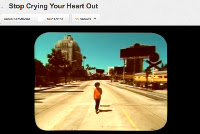 |
| Oasis - Narrative |
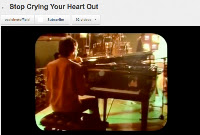 |
| Oasis - Performance |
 |
| The Script - Narrative |
 |
| The Script - Performance |
In hindsight, the ideal video would have been to film half a narrative with a decent story line to, and also half of a performance video with a whole band in a studio with proper microphones and other instruments, however this was not available to us at the time as no one in the group knew of any one that could help us in this way. As well as this, it would have been very difficult to get the right instruments in to a place where we could film the performance part as the song we used features many instruments that are quite large, i.e. a drum kit and piano.
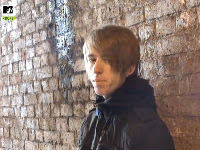 |
| Glenn Performing At First |
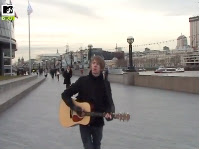 |
| Glenn Performing In Public |
Although this is what ideally we actually wanted to do, we had to be realistic with the time framing that we had, the people that were available and the equipment that we had. The best thing that we could do in regards to half performance and half narrative, was to have Glenn performing for the camera with his guitar in a quieter part of London, and then gradually ease him in to the busier parts and to perform more to the public.
Link Of Lyrics And Visuals
Another convention that we tried to use in the creation of our video was how the lyrics match the visuals on the screen. Below is just 6 of thousands of videos in the industry where the visuals reflect what is being sung.
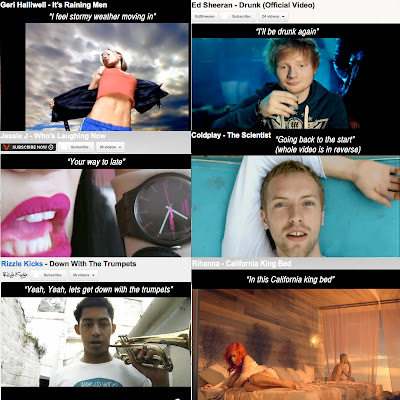 |
| Lyrics And Visuals |
(From top left anti-clockwise)
- Geri Halliwell's 'It's Raining Men' has a line "I feel stormy weather moving in" to which grey 'stormy' clouds are seen overhead;
- Jessis J's 'Who's Laughing Now' has a line "Your way too late" and there is an extreme close up of the artist singing this with a watch close to her mouth.
- Rizzle Kicks 'Down With The Trumpets' has a repetitive line of "Yeah Yeah, lets get down with the trumpets', and there is a trumpet that appears in the video with the artists throughout.
- Ed Sheeran's 'Drunk' has the line "I'll be drunk again" to which the artist is seen in a club drinking what appears to be a shot of alcohol, something typical of getting you drunk!
- Coldplay's 'The Scientist' is an iconic video that nearly everyone has seen. One of the lines in the song is "I'm going back to the start". The whole video is based on this line as it is all in reverse.
- Rihanna's 'California King Bed' and one of the lines is "In this California king bed" and there is an image of a huge bed.
Lyrics and visuals that we used;
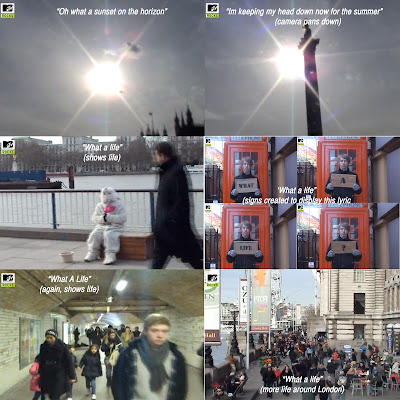 |
| Our Lyrics And Visuals |
With such a repetitive song, there was only so much that we could do in order to match the visuals and lyrics together. There is the repetitive line of 'What A Life' which is also the song title, so we decided in the planing stages that the idea was to try and convey life across London in as many different ways as possible. Above is some of the visuals that we managed to match with the lyrics being sung.
(From top left anti-clockwise)
- "Oh what a sunset on the horizon" was a line that we matched by filming the sun for a small time and then moving the camera across the sky. We felt that this was one visual that we should try and match as the sun is referenced to twice in the song.
- This visual is not necessarily seen when the line "What a life" is actually sung, but we felt it was appropriate because we thought that it conveyed life very well. What with it being a street artist, we liked how this was just a normal person either doing it for a living or just to entertain, and we liked this look on life.
- "What a life" was sung at this point in the video. We wanted to include as many shots as possible where there were a lot of people around. We thought that filming large groups of people was vital if we were going to convey life.
- As above.
- This image is of fur different shots from the video. Again, this was not matched to any lyric at the time of being shown as it was in fact an instrumental part of the song. Because of this, we decided to show the instrumental part y Glenn holding up a number of different wooden boards in different locations that read 'What A Life?'. This was one of the conventions that we developed as you do not really see visuals to do with the song when there is an instrumental, nor do you have actual writing that shows lyrics from the song.
- "I'm keeping my head down now for the summer" was another line in the song that we took advantage of when editing. In this instance, we again, filmed the sun, and then moved the camera down to eye level to give the audience a sense of moving down, which is exactly what the lyrics say.
In regards to music and visuals, we feel that we have in fact kept this convention and tried to develop it with the instrumental part of the song by still showing words associated with it.
Music And Visuals
The music and the visuals is another convention that we tried to use in the creation of our own music video. Ever single video that is a performance contains a musical instrument. the instruments that are used are the ones that the band would use if they were performing on the stage to an audience.
The song that we chose to try and produce a music video to as 'What A Life' by Noel Gallagher. Noel Gallagher was once part of famous indie rock group Oasis. Oasis were once one of the most notable bands of its genre of music with iconic songs such as 'Wonderwall', 'Stop Crying Your Heart Out' and 'Stand By Me'. Because the song we are using is sung by an artist that was once part of this group, I decided to look at how some of their videos looked. As you can see from above, I have looked at 'Wonderwall' and 'Little By Little' which all feature the individual band members. As well as this one of the videos is part performance and part narrative, and the other, Wonderwall, is a full performance video. Because of this, the instruments that are used to create the music are shown in both. When we were creating our video, we heavily based our model and the ideas from the video on Oasis and their style of music videos. We did this because Gallagher was in fact part of this band.
From looking at the two Oasis videos, you can see that a guitar appears in the 'Little By Little' video which is played by Noel Gallagher, and the other video 'Wonderwall' has every instrument that is heard throughout the song, so a guitar, drum and cello. We wanted to follow this convention so we had our model using the guitar, as shown below in the short video I have created using Final Cut.
We did not however use all instruments that can be heard in the video, simply because we did not have access to them, and we felt it would not have been appropriate to have them in the video seeing as it was a half narrative video, and a full set of instruments tend to appear in a full performance video.
Notion Of Looking
As stated above, one of Andrew Goodwin's conventions that he wrote about is a 'notion of looking'. By this he means that there is a frequent visual of screens within screens or looking through telescopes or binoculars, and that there is also particularly voyeuristic treatment of the female body. In regards to this convention, I do not feel that we have necessarily used this by objectifying something. We have however a few shots where the artist or 'audience' is looking at life around London which could give a sense of looking. The shots can be found below.
 |
| Slight Notion Of Looking As 'Glenn' Observes Life |
Intertextual References
There is not intertextual references in our video because the song that we are producing a video to has not been used in a film. Intertextual reference only occurs if the song is being used to promote a film, or if the song appears in the film. an example of this is Girls Aloud's 'Jump', which features clips from 'Love Actually'.
Click here for the video.
So, that is all of Andrew Goodwin's conventions assessed, however there are others that we adhered to when creating our video.
- The editing of a music video depends heavily on the genre of music and also the tempo of the track. An upbeat club song would be edited to the beat with cuts in quick concession. The video would probably lack transitions such as cross dissolves and fades, and would concentrate more on straight forward cutting. This adds to the excitement of the music as the pace of editing matches the pace of the music. We followed the convention of editing to the style of the music. We noted that our song was quite a laid back one so we felt that using straight cuts in quick concession was not necessary. As well as this, because we filmed a half narrative and half performance video, then having lots of quick cuts would have meant the audience would have become confused and not been able to understand the story line and message that we were trying to convey.
Looking back at the video, it is clear that my group were not prepared to take any risks. We did not challenge any conventions on purpose when filming because if we had have gotten it wrong, the video would have been ruined and the audience turned away. We did however challenge some conventions when creating our ancillary tasks.
Ancillary Tasks
Below are the ancillary tasks that my group completed after the production of the music video. There are a number of conventions that we stuck to, as well as some that we challenged when creating the promotional packages. The main and obvious convention that we stuck to was how the products relate to each other and have a consistent house style. Our products do have a house style as the same colours and fonts are used across the two platforms.
Digipak
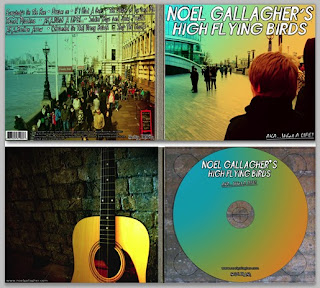 |
| Digipak |
The digipak was created first. The front cover features our model Glenn observing other people. The image is an over the shoulder shot and has been taken in a location that also appears in the video itself. The text is in plain white and clearly shows that the artist is Noel Gallagher and his new band 'High Flying Birds'. I believe that all of this is normal for a front cover of an album, apart from the picture. It is very rare that you have a picture of the back of an artist. Usually, the artist doesn't appear at all, and instead the name is visible, or there is a close up image of the artist to fully make the audience aware whose album it is. I feel that the main image of Glenn is a convention that we have challenged in order to create our digipak. You can see from the research stages of the digipak that every album cover has a picture of the artist where you can see their face.
 In regards to the rear of the digipak, I feel that we have not only stuck to the conventions of an album cover, but also developed some. The image is a still image from the video itself, and I think that having this further relates the products together. This is a convention that we developed as most albums either have blank background, or a picture that extends from the front cover. As well as this, I feel that we have developed the idea of how the track listings are presented. The vast majority of CD's have simplistic way of showing the tracks on the album. They do this by displaying the tracks one under the other in numerical order (and accompanying numbers). We however did not chose to do this. We originally wanted to, however the picture on the back was too good to fill it over with text, so instead, we had the track listings one after the other in a horizontal way and without numbers (seen right). After looking at the digipak, I feel that this does work well, especially in the font that it is in.
In regards to the rear of the digipak, I feel that we have not only stuck to the conventions of an album cover, but also developed some. The image is a still image from the video itself, and I think that having this further relates the products together. This is a convention that we developed as most albums either have blank background, or a picture that extends from the front cover. As well as this, I feel that we have developed the idea of how the track listings are presented. The vast majority of CD's have simplistic way of showing the tracks on the album. They do this by displaying the tracks one under the other in numerical order (and accompanying numbers). We however did not chose to do this. We originally wanted to, however the picture on the back was too good to fill it over with text, so instead, we had the track listings one after the other in a horizontal way and without numbers (seen right). After looking at the digipak, I feel that this does work well, especially in the font that it is in.

The other part of the rear of the digipak where a convention was followed was the legal disclaimers and barcode found at the bottom of the album (seen above). The legal disclaimers are something that ALL albums contain. Everything you buy has some small print that no one ever reads, but if you do read the small print on the album, it tells you about the production companies involved in creating the album and a disclaimer prohibiting other people to make copies of the song. As well as this, most albums have their company logo on, and we decided to do this by adding Noel Gallagher's record company logo, Sour Mash. The barcode was also added in the bottom left hand corner of the album, as everything that is intended to be brought from a shop NEEDS to have a barcode for it to be processed and logged.
Magazine
 |
| Magazine Advert |
The magazine advert has the same image as the one that is used on the digipak. We did this as our research told us that it was a common convention to follow when creating a promotional pack. As stated before, we feel that we should have used an image where the audience can actually see the artist and is not left guessing to who it actually is. Although we would change this if we had the chance to, we feel that we have followed a number of different conventions that we felt were mandatory when creating a magazine advert. The text that we have used is exactly the same as the digipak and is laid out in the exact way. We did this in order to keep a consistent house style across the platforms.
 |
| Pull Quote |
What makes the magazine advert different from the digipak is the extra pieces of text that we have included. The image on the left is of one of the pull quotes that we inserted. We noted that on the majority of posters there are quotes from well known media industries. The quotes that we have used actually appear on Noel Gallagher's own advert for his album and tour. We did this so as to keep the comments and user ratings as real as possible. Noel Gallagher's poster can be seen below. As well as the pull quote that we added to the advert, we also included a tag line to further promote the artist. The line says 'Number one album featuring AKA... What A Life, The Death of You and Me and If I Had a Gun'. The line is advertising Noel's album by naming a few of the songs that are on there. By putting 'Number One' we thought that it further promotes an album as an audience would see that it is doing well in the charts and may consider purchasing it for themselves.
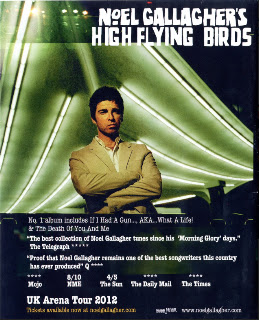 |
| Gallagher's Own Poster |
The ratings that we have also inserted is another convention that we have followed in the creation of our advert. Again, the ratings are taken straight off of Noel's poster so that we could use fair ratings that have actually been given to the artist. The ratings are something that we noticed that a lot of adverts contain. We realised that if well known media products such as magazines and TV shows rate an album, then it would cause an audience member to be more inclined to purchase the album.
The last convention that we feel we have followed, is by placing our artists website on the bottom of the page, as shown below, and also placing the company's logo on. In this instance, Sour Mash Records is the company that have produced the album. This is Noel Gallagher's own record label and he does not have a specific logo, so we wrote the company in a closest matched text as possible to the one that Gallagher uses himself. All adverts contain a website that promotes the artist further in order to give the audience somewhere to look if they want more information on their desired artist.
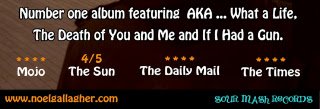 |
| Ratings |

































